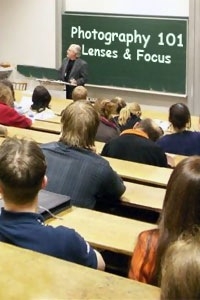Monday, March 24, 2008
Photography 101 - Lenses and Focus
Posted by Suhit Gupta in "Digital Home Articles & Resources" @ 07:00 AM
"As we touched on briefly in Lesson 1, light is a form of energy that can be bent. Bending light is called refraction. What happens when light is refracted is that it actually slows down. It’s a common misconception that light always travels at the same speed. In fact, the speed of the light depends on the type of material that it is travelling through. The really useful thing about refraction is that it can bend the path of light. I don’t want to get into the mysterious “dual nature of light”, but remember that light can be seen as a series of waves. Line after line of these waves make up light, similar to waves hitting a beach. Imagine we have a fishtank of water and a torch. For the sake of simplicity lets also imagine that we can see the beam clearly in the air and water. When you shine the torch at the surface of the water at an angle, from the side of the tank, you can see that the beam has been bent. The many wavefronts of the light are aligned perpendicular with its direction of travel. When the wavefronts encounter the water, one part of the front hits it before the rest. The part that has entered the water and slows down, while the rest of the wave is still travelling at the same speed. The effect of this is to bend the beam."

Fantastic lesson. Instead of telling one what settings to use in a camera, this class starts from the raw physics of light and how it bends when passing through the glass medium. Topics like focus, and focal length are also covered. This is recommended reading for those that didn't learn this in school or need a refresher.












